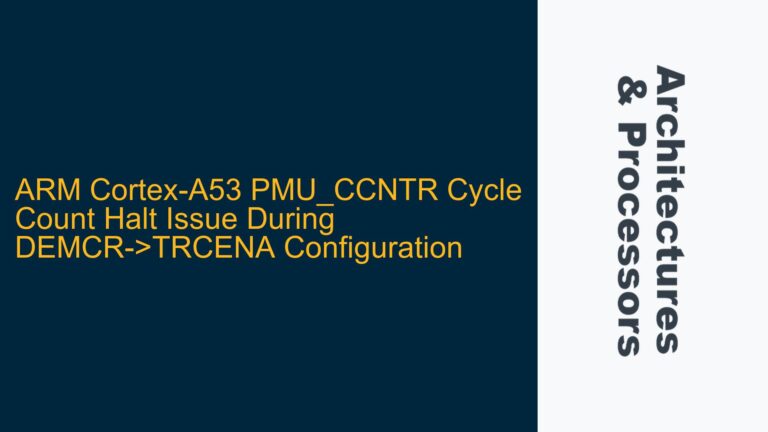Enabling ARMv8.3 PAC and ARMv8.5 MTE on AEMv8-A Base Platform RevC FVP
The AEMv8-A Base Platform RevC FVP is a powerful tool for simulating ARM-based systems, particularly for developers working on custom Linux kernels that leverage advanced ARM architecture features such as ARMv8.3 Pointer Authentication (PAC) and ARMv8.5 Memory Tagging Extension (MTE). These features are critical for enhancing system security and memory management, but enabling them on the FVP requires careful configuration. The FVP provides a flexible environment for testing and validation, but the process of enabling these features involves understanding the FVP’s parameterization system, the Linux kernel build process, and the interaction between the kernel and the simulated hardware.
The ARMv8.3 PAC feature introduces instructions for signing and authenticating pointers, which helps mitigate certain types of security vulnerabilities such as Return-Oriented Programming (ROP) attacks. ARMv8.5 MTE, on the other hand, allows memory tagging to detect spatial and temporal memory safety violations, which is particularly useful for debugging and securing applications. Running a custom Linux kernel with these features on the AEMv8-A Base Platform RevC FVP requires not only enabling the features in the FVP but also ensuring that the kernel is built with the appropriate configurations and that the boot process is correctly set up.
Configuration Parameters for ARMv8.3 and ARMv8.5 Features in FVP
The AEMv8-A Base Platform RevC FVP allows users to enable specific ARM architecture features through command-line parameters. These parameters are passed to the FVP executable when it is launched and control the behavior of the simulated hardware. For ARMv8.3 PAC and ARMv8.5 MTE, the relevant parameters are cluster*.has_arm_v8-3 and cluster*.has_arm_v8-5, respectively. These parameters must be set to 1 to enable the corresponding features. The * wildcard character can be used to apply the setting to all cores in a cluster, reducing the need for repetitive parameter specification.
For example, to enable both ARMv8.3 PAC and ARMv8.5 MTE on all cores in a cluster, the following command-line options can be used:
-C cluster0.has_arm_v8-3=1 -C cluster0.has_arm_v8-5=1
These parameters ensure that the simulated hardware supports the required features, but they do not automatically configure the Linux kernel to use them. The kernel must be built with the appropriate configurations to take advantage of these features.
Building and Booting a Custom Linux Kernel with ARMv8.3 and ARMv8.5 Support
To run a custom Linux kernel on the AEMv8-A Base Platform RevC FVP with ARMv8.3 PAC and ARMv8.5 MTE support, the kernel must be built with the appropriate configurations. This involves modifying the kernel’s build configuration to enable support for these features and ensuring that the kernel is compiled with the correct toolchain.
First, the kernel configuration must be updated to include support for ARMv8.3 PAC and ARMv8.5 MTE. This can be done by setting the following options in the kernel’s .config file:
CONFIG_ARM64_PTR_AUTH=y
CONFIG_ARM64_MTE=y
These options enable the kernel to use the PAC and MTE features provided by the hardware. Additionally, the kernel must be built with a toolchain that supports these features. The toolchain must include the appropriate compiler flags to generate code that uses the new instructions and registers introduced by ARMv8.3 and ARMv8.5.
Once the kernel is built, it can be loaded onto the FVP using the appropriate bootloader. The bootloader must be configured to pass the necessary parameters to the kernel, such as enabling PAC and MTE at runtime. This can be done by modifying the bootloader’s configuration or by passing command-line arguments to the kernel.
For example, to enable MTE at runtime, the following kernel command-line parameter can be used:
mte=on
This parameter ensures that the kernel enables MTE during the boot process. Similarly, PAC can be enabled by ensuring that the kernel is built with the appropriate configurations and that the hardware supports the feature.
Debugging and Verifying ARMv8.3 and ARMv8.5 Features on FVP
After enabling ARMv8.3 PAC and ARMv8.5 MTE on the FVP and building the custom Linux kernel with support for these features, it is important to verify that the features are functioning correctly. This involves running tests and debugging any issues that arise during the boot process or while running applications.
One common issue is that the kernel may fail to boot if the hardware does not support the required features or if the kernel is not configured correctly. In this case, it is important to check the FVP’s output logs to determine the cause of the failure. The logs may indicate that the hardware does not support the requested features or that the kernel is attempting to use features that are not enabled.
Another potential issue is that applications may not behave as expected when using PAC or MTE. This can be due to incorrect configuration of the kernel or the application itself. To debug these issues, it is important to use tools such as GDB to step through the code and verify that the correct instructions are being used. Additionally, the FVP provides features for tracing and profiling, which can be used to analyze the behavior of the system and identify any performance bottlenecks or unexpected behavior.
Optimizing Performance and Resource Usage with ARMv8.3 and ARMv8.5 Features
Enabling ARMv8.3 PAC and ARMv8.5 MTE on the AEMv8-A Base Platform RevC FVP can have an impact on system performance and resource usage. PAC introduces additional instructions for signing and authenticating pointers, which can increase the size of the code and the number of instructions executed. MTE, on the other hand, introduces additional memory overhead for storing tags and requires additional processing to check tags during memory accesses.
To optimize performance and resource usage, it is important to carefully configure the kernel and the applications to minimize the impact of these features. This can be done by selectively enabling PAC and MTE for specific parts of the code or by using compiler optimizations to reduce the overhead of these features. Additionally, the FVP provides options for configuring the memory system and the cache, which can be used to improve performance and reduce resource usage.
For example, the FVP allows users to configure the size and associativity of the caches, which can have a significant impact on performance. By tuning these parameters, it is possible to reduce the number of cache misses and improve the overall performance of the system. Additionally, the FVP provides options for configuring the memory system, such as the number of memory channels and the memory latency, which can be used to optimize the performance of memory-intensive applications.
Conclusion
Running a custom Linux kernel on the AEMv8-A Base Platform RevC FVP with ARMv8.3 PAC and ARMv8.5 MTE support requires careful configuration of both the FVP and the kernel. By enabling the appropriate features in the FVP and building the kernel with the correct configurations, it is possible to take advantage of these advanced ARM architecture features. However, it is important to verify that the features are functioning correctly and to optimize performance and resource usage to ensure that the system meets its requirements. With the right configuration and testing, the AEMv8-A Base Platform RevC FVP provides a powerful environment for developing and validating custom Linux kernels with advanced security and memory management features.






